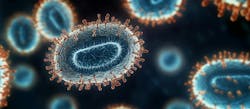Cases of respiratory illnesses like walking pneumonia and whooping cough are surging. Why?
Since last spring, the number of infections caused by Mycoplasma pneumoniae, a bacterial cause of ‘walking pneumonia,’ has been increasing. The U.S. Centers for Disease Control and Prevention (CDC) issued an alert advising the rate of cases, especially among young children ages 2–4, differs from previous years, when most infections were observed among school-aged children and adolescents.1
While symptoms can be mild — not necessitating staying home in bed, hence its name — serious complications can occur that may require hospitalization. These complications can also leave behind long-lasting effects, like new or worsening asthma and, in some cases, encephalitis or brain disease.
Though there is no national surveillance system in place to track cases of walking pneumonia, the CDC has observed an increase in emergency visits with a discharge diagnosis of walking pneumonia among all age groups. In addition, test positivity for the pathogen has been high, with outbreaks occurring mostly in crowded environments. On top of this, many states are reporting increasing diagnoses of pertussis (also known as whooping cough) another respiratory illness caused by the bacterium Bordetella pertussis.
So, how can laboratory professionals ensure they are staying on top of testing, diagnosis, and treatment when these and other respiratory illnesses are growing in prevalence even before the traditional ‘cold and flu’ season?
2024’s post-COVID reemergence of respiratory pathogens
The United States is currently experiencing high rates of whooping cough cases, especially among children. Infection rates in 2024 are eclipsing what was seen in the prior year, with numbers returning to pre-pandemic trends.2 While the pandemic saw lower rates, likely due to mitigation measures like remote learning and masking, cases this year are higher than in 2019 before the start of the pandemic.3 Outbreaks of whooping cough also tend to be cyclical, with peaks in reported cases occurring every 2–5 years.
Why are these upper respiratory pathogens reemerging, and at such high levels? During the COVID-19 pandemic, many non–SARS-CoV-2 respiratory diseases saw periods of low incidence of infection. Now that pandemic restrictions have been lifted and people have returned to their normal activities, seasonal respiratory diseases are able to spread person-to-person through droplet and aerosol routes as usual.
This is affecting children particularly hard, as some have not yet been exposed to many of these respiratory pathogens, causing an ‘immunity gap.’4 Additionally, the mitigation efforts enacted during the COVID-19 pandemic to slow disease spread affected the seasonality and cyclical outbreak patterns of several respiratory pathogens.5 We are now observing a return to these outbreak patterns while simultaneously dealing with immunity gaps in the population.
Accurately identifying these infections so that patients can be properly managed is met with several unique challenges. First, these respiratory conditions often have symptoms that are similar. Respiratory pathogens can cause coughing, headaches, fever, runny nose, and a number of other common symptoms that can be difficult to differentiate. And testing for these illnesses, which are often needed to identify the specific bacteria or virus causing the infection, can be underutilized for certain populations or clinical settings.6
What to know about testing
With the increase in cases of M. pneumoniae, whooping cough, and other respiratory pathogens, laboratory testing plays a critical role in helping providers identify, differentiate, and treat these illnesses. Testing is particularly crucial for hospitalized children, who may be especially vulnerable to complications.
Testing for M. pneumoniae is often done in hospital settings, but samples can also be collected in an outpatient clinic, wherein a healthcare provider will collect an upper respiratory swab for testing. M. pneumoniae is commonly part of a panel that tests for many pathogens, including flu, COVID-19, and other viruses and bacteria (i.e., a syndromic panel). This panel approach can be useful in ruling out other diseases that may require specific antibiotics, so that patients with walking pneumonia receive access to the care needed as soon as possible, before their condition worsens. Targeted testing for M. pneumoniae is offered at several laboratories as a laboratory-developed test (LDT).
Whooping cough can be difficult to diagnose in its early stages, as its symptoms typically mirror other respiratory illnesses. Once the illness has progressed, a clinician may be able to make a diagnosis through a physical exam and by testing an upper respiratory swab for the B. pertussis bacteria using a rapid polymerase chain reaction (PCR) test.7 There are several options for PCR testing for both B. pertussis and a related pathogen, B. parapertussis, available as LDTs and FDA-approved assays. These pathogens are also a detectable target on several syndromic respiratory panels.
Fortunately, testing methods have improved over the last few years, allowing clinicians to catch more cases of these diseases. With diagnostic PCR test methods now widely available, laboratory tests can identify cases in 2024 that may have been missed in prior years.8
How to prevent the spread of respiratory illnesses
We have learned much about respiratory droplets over the last few years. Unfortunately, symptoms of these conditions, like coughing and sneezing, can accelerate the spread of pathogens. Strategies like handwashing and covering the nose and mouth can mitigate the spread.
Vulnerable patient populations can also consider avoiding crowded environments where outbreaks are likely and staying on top of their vaccines. By being aware of symptoms of walking pneumonia and whooping cough, a patient can get tested by their provider quickly and receive treatment before complications arise.
Lessons learned from the COVID-19 pandemic: What can we apply to other respiratory illnesses?
In the thick of the COVID-19 pandemic, practices like frequent handwashing, social distancing, and sanitizing shared surfaces were commonplace. Some preventative measures, like staying home when symptoms of sickness are felt and avoiding others who might be sick, helps to prevent spread of disease. Vaccination is also critical to reducing risk from influenza, COVID-19, and whooping cough.
Throughout ‘cold and flu season,’ respiratory illnesses can become difficult to track given their prevalence. It is important for individuals to visit their doctor if they feel unwell so a test can be procured if needed and a treatment prescribed, if available. Experts have predicted a seasonal outlook similar to what was experienced last season — meaning the number of hospitalizations for flu, COVID-19, RSV, and other respiratory illnesses is expected to hold steady.9
Preventing the spread of walking pneumonia, whooping cough, and other infectious diseases this year is something we can all take steps towards together. The rising number of cases can and should encourage individuals to be more mindful about their own symptoms, so that conditions can be addressed at their onset before they are spread further.
Testing for (and treating) these illnesses is vital. We can all do our part to lessen the impact of a bad respiratory illness season — even beyond when the weather warms.
References
- CDC. Mycoplasma pneumoniae infections have been increasing. National Center for Immunization and Respiratory Diseases. October 18, 2024. Accessed December 3, 2024. https://www.cdc.gov/ncird/whats-new/mycoplasma-pneumoniae-infections-have-been-increasing.html.
- CDC. Whooping cough is on the rise, returning to pre-pandemic trends. National Center for Immunization and Respiratory Diseases. October 23, 2024. Accessed December 3, 2024. https://www.cdc.gov/ncird/whats-new/cases-of-whooping-cough-on-the-rise.html.
- CDC. Pertussis surveillance and trends. Whooping Cough (Pertussis). December 2, 2024. Accessed December 3, 2024. https://www.cdc.gov/pertussis/php/surveillance/index.html.
- Ang HJ, Menegale F, Preziosi G, et al. Reconstructing the impact of COVID-19 on the immunity gap and transmission of respiratory syncytial virus in Lombardy, Italy. EBioMedicine. 2023;95:104745. doi:10.1016/j.ebiom.2023.104745.
- Gavenčiak T, Monrad JT, Leech G, et al. Seasonal variation in SARS-CoV-2 transmission in temperate climates: A Bayesian modelling study in 143 European regions. PLoS Comput Biol. 2022;18(8):e1010435. doi:10.1371/journal.pcbi.1010435.
- Caliendo AM, Gilbert DN, Ginocchio CC, et al. Better tests, better care: improved diagnostics for infectious diseases. Clin Infect Dis. 2013;57 Suppl 3(Suppl 3):S139-70. doi:10.1093/cid/cit578.
- American Lung Association. Pertussis symptoms and diagnosis. Lung.org. Accessed December 3, 2024. https://www.lung.org/lung-health-diseases/lung-disease-lookup/pertussis/symptoms-diagnosis.
- Attaway CC, Wang H. Laboratory testing for respiratory viruses for the clinician. Cleve Clin J Med. 2024;91(9 suppl 1):S42-S49. doi:10.3949/ccjm.91.s1.07.
- CDC. Monitoring respiratory illnesses informs decision making. National Center for Immunization and Respiratory Diseases. October 21, 2024. Accessed December 3, 2024. https://www.cdc.gov/ncird/whats-new/monitoring-respiratory-illnesses-informs-decision-making.html.





